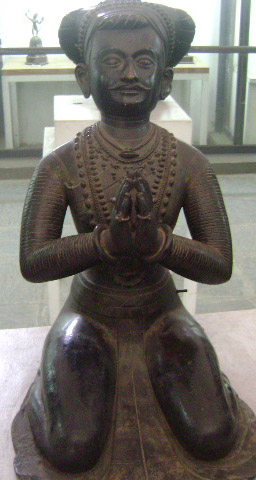
The history of Nepal is intertwined with the history of the broader Indian subcontinent and the surrounding regions, comprising the areas of South Asia and East Asia.

Licchavi was a kingdom which existed in the Kathmandu Valley in modern-day Nepal from approximately 400 to 750 CE. The Licchavi clan originated from Vaishali, and conquered Kathmandu Valley. The Lichchhavis elected an administrator and representatives to rule them.

Princess Bhrikuti Devi of Licchavi is traditionally considered to have been the first wife and queen of the earliest emperor of Tibet, Songtsen Gampo, and an incarnation of Tara. She was also known as "Besa", and was a princess of the Licchavi kingdom of Nepal and later the queen consort of Tibet.

Harshavardhana was a Pushyabhuti emperor who ruled northern India from 606 to 647 CE. He was the son of Prabhakaravardhana who had defeated the Alchon Hun invaders, and the younger brother of Rajyavardhana, a king of Thanesar, present-day Haryana.

Amshuverma or Amshu Verma rose to the position of Mahasamanta about 595 CE when King Shivadeva I was ruling in the Licchavi (kingdom) of Nepal. By 604 AD Sivadeva was reduced to a mere figurehead by Amshuverma within years of his appointment as Samanta, a feudal lord. His rule appears to have ended before 621 AD when crown prince Udaydeva became King.
Arimalla, also known as Aridev Malla, was the first king of the Malla dynasty in the Kathmandu valley, also known as Nepal Mandala at that time.

Bouddha, also known as Boudhanath, Khasti Chaitya and Khāsa Chaitya is a stupa in Kathmandu, Nepal. Located about 11 km (6.8 mi) from the center and northeastern outskirts of Kathmandu, its massive mandala makes it one of the largest spherical stupas in Nepal and the world.
Tridu Songtsen, Tridu Songtsen or Dusong Mangban, was an emperor of the Tibetan Empire from 676 to 704.
Raya Malla was a Malla Dynasty king and the first King of Bhadgaon after the division of Kathmandu Valley into Kantipur, Patan, and Bhadgaon. He reigned from 1482 until his death in 1505. He was the son of Jayayakshya Malla. His younger brother, Ratna Malla, ruled over Kantipur.
Siva Simha Malla, also known as Shiva Simha or Shivasimha, was a Malla ruler and the sixth king of Kantipur. He started his reign on 1578 after deposing his brother Sadashiva Malla.
King Mānadeva, also Mandev or Mandeva, was a king of Licchavi dynasty in present-day Nepal. He was the son of Dharmadeva, grandson of Shankardeva and the great grandson of Vrsadeva. He suppressed the feudal chiefs of the east and west and also conquered Mallapuri. He minted coins called Mananka and constructed the palace of Managriha for himself which later became a centre of administration of the Licchavi kings.
Ratna Malla was a Malla king and the first independent king of Kantipur. He was one of the six sons of Yakshya Malla.
Amara Malla was a king of the Malla dynasty and the third king of Kantipur. He succeeded his father Surya Malla and ruled from 1530 to 1560.
Narendradeva or Narendra Deva was a Licchavi king who ruled from 643–679. He was the son of Uday Deva. He initiated diplomatic relations with the Chinese emperor and oversaw the development of Nepal as a trade gateway between India and Tibet. Nepal in the reign of Narendra Deva was generally seen as a prosperous and powerful country. With the improved relation with China and Tibet, it was seen as a thriving centre by serving as a gateway from India to China for all kinds of people. It was around this time the art of paper making was introduced to Nepal from China. Nepal exported some finest quality handmade paper, along with musk, orpiment, blankets, etc. to India.

The Kingdom of Bhaktapur, also known as Bhadgaon, was a kingdom ruled by the Malla dynasty of Nepal from 15th century until its annexation in the 18th century. It was established in 1482 after King Yaksha Malla died and his sons divided the valley into four kingdoms: Bhaktapur, Kantipur, Patan, and Banepa. Banepa, however, was soon annexed by or submitted itself to Bhaktapur.
Shivadeva I was a king of the Licchavi dynasty who ruled Nepal in around 590 C.E. He was the son of Mana Deva II and lived in a nine-storeyed palace called the Kailashkut Bhavan.
Jayadeva II was the son of Shivadeva II and a king of the Licchavi dynasty who ruled Nepal in around 700 C.E.
Loka Prakash Malla, also known as Lokaprakash, was a Malla dynasty king and the King of Patan. He succeeded Yoganarendra Malla as the king in 1605 and reigned for a brief period of eleven months.
Udaydeva was the son of Shivadeva I and a Lichchhavi king of Nepal. He succeeded Amshuverma in 621 CE but was soon ousted by Jishnu Gupta, and his brother Dhruvadeva. He is also believed to be the father of Bhrikuti.
Dhruvadeva, also spelled Dhruva Deva, was a son of Shivadeva I of the Licchavi dynasty and a king of Nepal in the 7th century. He deposed his brother Udaydeva with the help of Jishnu Gupta and reigned as a figurehead monarch.





